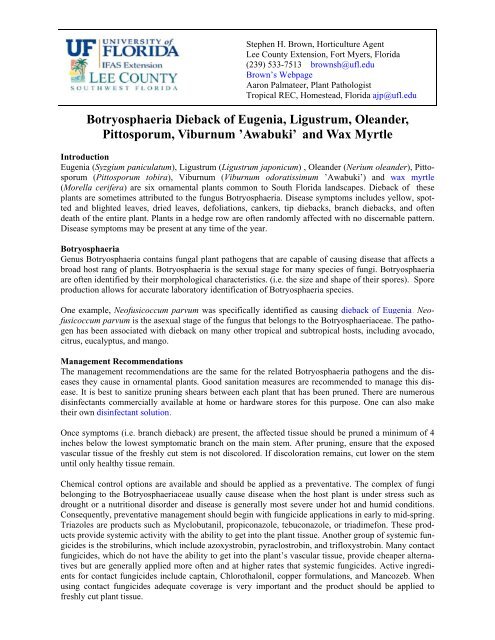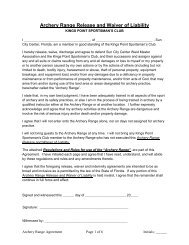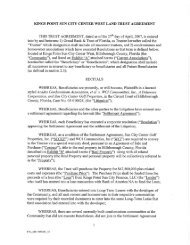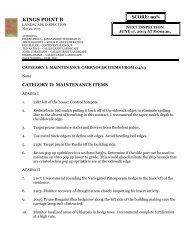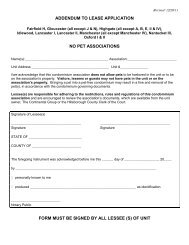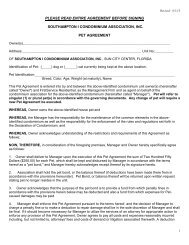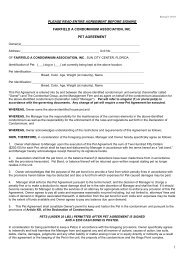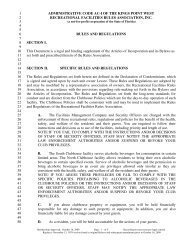Botryosphaeria Dieback of Eugenia, Ligustrum, Oleander ...
Botryosphaeria Dieback of Eugenia, Ligustrum, Oleander ...
Botryosphaeria Dieback of Eugenia, Ligustrum, Oleander ...
Create successful ePaper yourself
Turn your PDF publications into a flip-book with our unique Google optimized e-Paper software.
Stephen H. Brown, Horticulture Agent<br />
Lee County Extension, Fort Myers, Florida<br />
(239) 533-7513 brownsh@ufl.edu<br />
Brown’s Webpage<br />
Aaron Palmateer, Plant Pathologist<br />
Tropical REC, Homestead, Florida ajp@ufl.edu<br />
<strong>Botryosphaeria</strong> <strong>Dieback</strong> <strong>of</strong> <strong>Eugenia</strong>, <strong>Ligustrum</strong>, <strong>Oleander</strong>,<br />
Pittosporum, Viburnum ’Awabuki’ and Wax Myrtle<br />
Introduction<br />
<strong>Eugenia</strong> (Syzgium paniculatum), <strong>Ligustrum</strong> (<strong>Ligustrum</strong> japonicum) , <strong>Oleander</strong> (Nerium oleander), Pittosporum<br />
(Pittosporum tobira), Viburnum (Viburnum odoratissimum ’Awabuki’) and wax myrtle<br />
(Morella cerifera) are six ornamental plants common to South Florida landscapes. <strong>Dieback</strong> <strong>of</strong> these<br />
plants are sometimes attributed to the fungus <strong>Botryosphaeria</strong>. Disease symptoms includes yellow, spotted<br />
and blighted leaves, dried leaves, defoliations, cankers, tip diebacks, branch diebacks, and <strong>of</strong>ten<br />
death <strong>of</strong> the entire plant. Plants in a hedge row are <strong>of</strong>ten randomly affected with no discernable pattern.<br />
Disease symptoms may be present at any time <strong>of</strong> the year.<br />
<strong>Botryosphaeria</strong><br />
Genus <strong>Botryosphaeria</strong> contains fungal plant pathogens that are capable <strong>of</strong> causing disease that affects a<br />
broad host rang <strong>of</strong> plants. <strong>Botryosphaeria</strong> is the sexual stage for many species <strong>of</strong> fungi. <strong>Botryosphaeria</strong><br />
are <strong>of</strong>ten identified by their morphological characteristics. (i.e. the size and shape <strong>of</strong> their spores). Spore<br />
production allows for accurate laboratory identification <strong>of</strong> <strong>Botryosphaeria</strong> species.<br />
One example, Ne<strong>of</strong>usicoccum parvum was specifically identified as causing dieback <strong>of</strong> <strong>Eugenia</strong>. Ne<strong>of</strong>usicoccum<br />
parvum is the asexual stage <strong>of</strong> the fungus that belongs to the <strong>Botryosphaeria</strong>ceae. The pathogen<br />
has been associated with dieback on many other tropical and subtropical hosts, including avocado,<br />
citrus, eucalyptus, and mango.<br />
Management Recommendations<br />
The management recommendations are the same for the related <strong>Botryosphaeria</strong> pathogens and the diseases<br />
they cause in ornamental plants. Good sanitation measures are recommended to manage this disease.<br />
It is best to sanitize pruning shears between each plant that has been pruned. There are numerous<br />
disinfectants commercially available at home or hardware stores for this purpose. One can also make<br />
their own disinfectant solution.<br />
Once symptoms (i.e. branch dieback) are present, the affected tissue should be pruned a minimum <strong>of</strong> 4<br />
inches below the lowest symptomatic branch on the main stem. After pruning, ensure that the exposed<br />
vascular tissue <strong>of</strong> the freshly cut stem is not discolored. If discoloration remains, cut lower on the stem<br />
until only healthy tissue remain.<br />
Chemical control options are available and should be applied as a preventative. The complex <strong>of</strong> fungi<br />
belonging to the <strong>Botryosphaeria</strong>ceae usually cause disease when the host plant is under stress such as<br />
drought or a nutritional disorder and disease is generally most severe under hot and humid conditions.<br />
Consequently, preventative management should begin with fungicide applications in early to mid-spring.<br />
Triazoles are products such as Myclobutanil, propiconazole, tebuconazole, or triadimefon. These products<br />
provide systemic activity with the ability to get into the plant tissue. Another group <strong>of</strong> systemic fungicides<br />
is the strobilurins, which include azoxystrobin, pyraclostrobin, and trifloxystrobin. Many contact<br />
fungicides, which do not have the ability to get into the plant’s vascular tissue, provide cheaper alternatives<br />
but are generally applied more <strong>of</strong>ten and at higher rates that systemic fungicides. Active ingredients<br />
for contact fungicides include captain, Chlorothalonil, copper formulations, and Mancozeb. When<br />
using contact fungicides adequate coverage is very important and the product should be applied to<br />
freshly cut plant tissue.
<strong>Eugenia</strong> —Early October<br />
S.H. Brown<br />
S.H. Brown<br />
Yellowing and spotted leaves<br />
Twig dieback<br />
Plant dieback<br />
S.H. Brown<br />
Stems with cnacker<br />
S.H. Brown
<strong>Eugenia</strong>—Early October<br />
Moderately affected<br />
Most affected<br />
Least affected<br />
Various degrees <strong>of</strong> <strong>Botryosphaeria</strong> affected plants that were used to conceal an conditioner<br />
S.H. Brown<br />
Sporadic dieback <strong>of</strong> plants in a hedge row<br />
S.H. Brown
<strong>Ligustrum</strong>—Late June<br />
<strong>Botryosphaeria</strong> sections <strong>of</strong> this shrub have been removed<br />
S.H. Brown<br />
Affected leaves<br />
S.H. Brown<br />
Discolored affected stems<br />
S.H. Brown
<strong>Oleander</strong> —Early November<br />
Two dead oleander trees are among others <strong>of</strong> the same species<br />
S.H. Brown<br />
S.H. Brown<br />
First signs <strong>of</strong> cankers that may eventually girdle<br />
the tree<br />
Limb dieback<br />
Dried leaves and stems<br />
S.H. Brown
Pittosporum—Mid July<br />
Affected hedge midsection<br />
S.H. Brown<br />
Affected leaves<br />
S.H. Brown
‘Awabuki’ Viburnum — Late May<br />
<strong>Botryosphaeria</strong> affected hedge row with “recovering” and defoliated plants<br />
S.H. Brown<br />
Large canker<br />
S.H. Brown<br />
Defoliated plants and exposed cankers<br />
S.H. Brown
Wax Myrtle — Late August<br />
The removal <strong>of</strong> infested stems leaves large holes in the canopies <strong>of</strong> two wax myrtle plants<br />
Degrees <strong>of</strong> stem infections<br />
Stem canker
The Necessity <strong>of</strong> Laboratory Analyses<br />
Disease symptoms <strong>of</strong> various fungi are <strong>of</strong>ten similar in appearance. A laboratory analysis is <strong>of</strong>ten necessary<br />
to determine the cause <strong>of</strong> a plant’s decline and consequently recommended treatment. You may<br />
submit plants for analysis to UF Extension Plant Diagnostic Center, 2570 Hull Road, Gainesville, FL<br />
32511. Phone (352) 392-1795, Fax (352) 392-3438.<br />
References<br />
Harmon, P.F. and Bledsoe, S.D. 2012. Pr<strong>of</strong>essional Management Guide for Ornamental Plants. #PP202.<br />
UF/IFAS, Gainesville, Florida<br />
Palmateer, A.J. and Tamowski, T.B., 2011. Branch dieback <strong>of</strong> Syzgium paniculatum (<strong>Eugenia</strong>). EDIS<br />
#PP283. UF/IFAS, Gainesville, Florida<br />
Useful Links<br />
Anthracnose<br />
Indian Hawthorn Diseases and Disorder<br />
Fungicide Survey <strong>of</strong> Lee County<br />
Hibiscus Insect Problems<br />
Key Plants / Key Pests<br />
Stinkhorns<br />
Whitefly (Rugose Spiraling)<br />
Florida Native Palms<br />
Florida Native Plants Fact Sheets<br />
This fact sheet was reviewed by Peggy Cruz, Lee County Extension<br />
The Institute <strong>of</strong> Food and Agricultural Sciences (IFAS) is an Equal Opportunity Institution authorized to provide research, educational information<br />
and other services only to individuals and institutions that function with non-discrimination with respect to race, religion, age, disability,<br />
sex, sexual orientation, martial status, national origin, political opinions or affiliations. U.S. Department <strong>of</strong> Agriculture, Cooperative Extension<br />
Service, University <strong>of</strong> Florida, IFAS, Florida A. & M. 1/2013.


